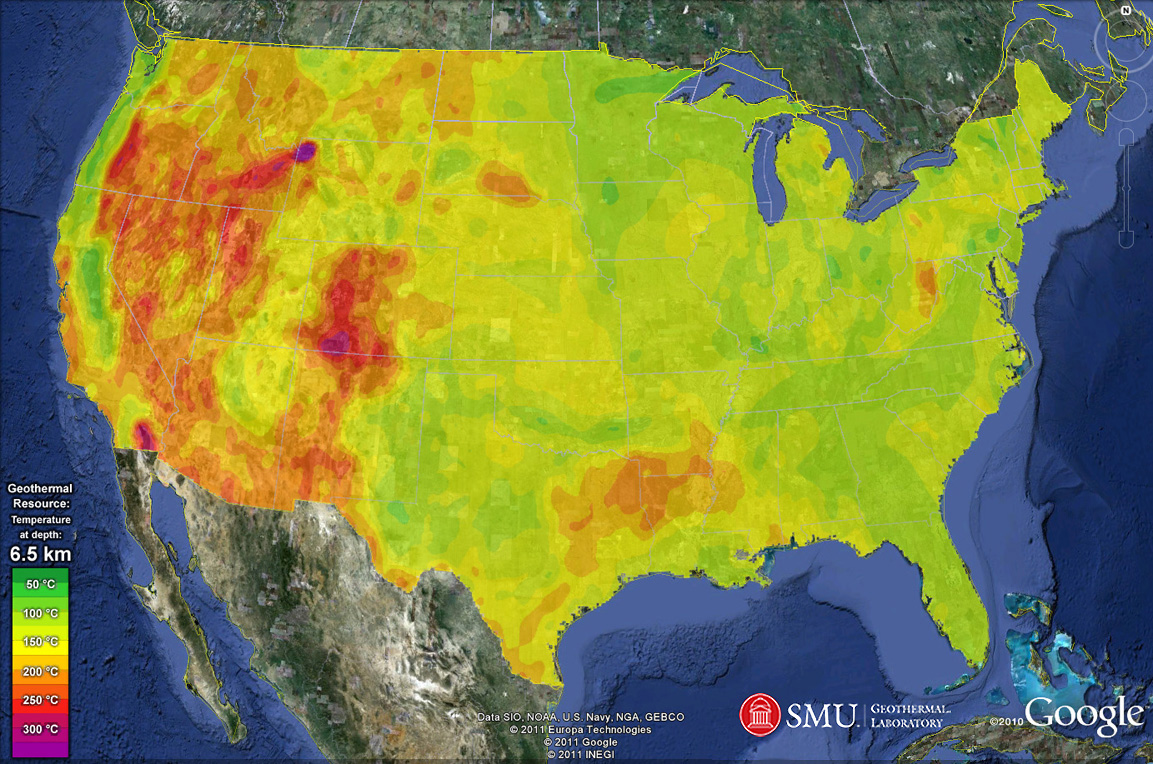If wishes were horses, we’d all get ponies for Christmas: Geothermal Edition

Guest “My sincere apologies to whoever (or is it whomever?) originally coined the phrase, If wishes were horses,” by David Middleton
[I]f the Texas drilling industry drilled as many geothermal wells as it currently does oil and gas, about 15,000 per year, the state could run itself off geothermal power by 2027.
- If the “Texas drilling industry” drilled as many CCS wells “as it currently does oil and gas wells,” the state could sequester more CO2 than is emitted from all fixed emission sources, nationwide.
- If the “Texas drilling industry” drilled as many deep disposal wells into crystalline basement rock “as it currently does oil and gas wells,” the state could safely dispose of every last bit of high level radioactive waste in these United States.
- If wishes were horses, we’d all get ponies for Christmas.
Firstly, “Texas” doesn’t have a “drilling industry.” Secondly, if the drilling industry that currently drills oil & gas wells in Texas could make more money drilling geothermal wells than drilling oil & gas wells, we would be drilling geothermal wells rather than oil & gas wells.
Here are some “highlights” from the article:
EQUILIBRIUM & SUSTAINABILITY
Geothermal energy could be off-ramp for Texas oil
BY SAUL ELBEIN 01/24/23AUSTIN, Texas — Four years of drilling for energy deep underground would be enough to build Texas a carbon-free state electric grid, a new study by an alliance of state universities has found.
The state’s flagship universities — including the University of Texas at Austin, Rice University and Texas A&M University — collaborated with the International Energy Agency to produce the landmark report.
[…]
“Rock is a great heat battery, and the upper 10 miles of the core holds an estimated 1,000 years’ worth of our energy needs in the form of stored energy,” Wisan added.
Most of the state’s population lives above potentially usable geothermal heat — as long as there’s a will to drill deep enough.
Superheated trapped steam that is nearly 300 degrees Fahrenheit — the sweet spot for modern geothermal — is accessible about three to five miles below the state capital of Austin and 2 1/2 to 3 miles beneath its most prominent city of Houston, the report found.
[…]
According to the Energy Information Agency, the state’s substantial renewable potential is meeting part of this growth: Texas leads the nation in wind energy and has near-leading solar potential.
But the Republican-dominated legislature…
[…]
The International Energy Agency declared in May 2021 that for the world to meet global climate goals, new oil and gas production would have to cease, as The Hill reported.
Since that warning, global oil and gas production has continued to increase — and is on track to hit record levels in 2023. But Tuesday’s report, which the global energy watchdog helped produce, suggested that geothermal energy could be a politically palatable offramp for the industry.
The report found that if the Texas drilling industry drilled as many geothermal wells as it currently does oil and gas, about 15,000 per year, the state could run itself off geothermal power by 2027.
[…]
[E]ventually, the fossil fuel industry began to drill and advance. “And then sure enough, now we’re drilling in 5,000 feet of water offshore with billion-dollar, technically complex wells,” Beard said.
“And that is what we could do for geothermal, right?” she said. “We could go for the deepwater of geothermal, and we can do it in the next few decades.”
The “landmark report” can be downloaded from the University of Texas at Austin Energy Institute. I downloaded the report. It’s not awful. The sections on the geology are actually quite well done.
I have nothing against geothermal energy, where an economic resource exists.
This sort of thinking doesn’t reflect economics:
Superheated trapped steam that is nearly 300 degrees Fahrenheit — the sweet spot for modern geothermal — is accessible about three to five miles below the state capital of Austin and 2 1/2 to 3 miles beneath its most prominent city of Houston, the report found.
Three to five miles beneath Austin? That’s 15,840 to 26,400 feet. There haven’t been a lot of oil & gas wells drilled in Travis County and I don’t think any have been drilled in Austin city limits. Considering that the average depth of wells drilled in Travis County is only about 800 feet, I’m fairly certain that none of them were drilled to depths of 15,840 to 26,400 feet. And I’m fairly certain that no wells will ever be drilled that deep under the city of Austin.
Austin is at the southeast end of this cross section. Paleozoic basement rock is less than 2,000′ below the surface.
That sort of “thinking” would conclude that the Kola Superdeep Borehole was a good start… Although, the idea of converting coal-fired power plants into geothermal power plants, connected to Superdeep boreholes, drilled by Doctor Evil “laser” beams, is a pretty cool idea, from a bad science fiction movie perspective.
Radical Plan To Make Earth’s Deepest Hole Could Unleash Limitless Energy
TECH
09 March 2022
By MIKE MCRAESince its launch in 2020, a pioneering energy company called Quaise has attracted some serious attention for its audacious goal of diving further into Earth’s crust than anybody has dug before.
Following the closure of first round venture capital funding, the MIT spin-off has now raised a total of US$63 million: a respectable start that could potentially make geothermal power accessible to more populations around the world.
The company’s vision for getting closer to the center of the Earth is to combine conventional drilling methods with a megawatt-power flashlight inspired by the kind of technology that could one day make nuclear fusion energy possible.
[…]
To date our best efforts at chewing our way through the planet’s skin have bottomed out at around 12.3 kilometers (7.6 miles). While the Kola Superdeep Borehole and others like it may have reached their limit, though, they nonetheless represent amazing feats of engineering.
[…]
Born out of nuclear fusion research at MIT Plasma Science and Fusion Center, Quaise’s solution is to use millimeter long waves of electromagnetic radiation that force atoms to melt together.
Devices called gyrotrons can efficiently churn out continuous beams of electromagnetic radiation by shaking electrons at high speed inside powerful magnetic fields.
By hooking a megawatt-power gyrotron up to the latest in cutting tools, Quaise expects to be able to blaze its way through the toughest, hottest rock, down to depths of around 20 kilometers (12.4 miles) in a matter of months.
[…]
By 2028, the company hopes to be able to take over old coal-fueled power stations, transforming them into facilities powered by steam instead.
[…]
$63 million and just the right attitude:
A truly equitable clean energy source, abundantly available near every population and industrial center on the planet.
How we got here
Carlos Araque spent fifteen years working at one of the world’s foremost providers of drilling services to the oil and gas industry. Seeing the negative impacts of that industry firsthand made him want to do something to help make things better. Quaise’s deep drilling technology is the result of a decade of research conducted by Paul Woskov at the MIT Plasma Science and Fusion Center.
Aaron Mandell knew both Paul and Carlos and put them all at the table together. Once the first conversation started everyone knew it was a once-in-a-generation idea. Vinod Khosla was the first backer, bringing our ideas to life. Two years later, The Engine, a venture fund built by MIT, led the seed round to help take our technology to market.
According to their timeline, by 2024, they’ll have built the “first full-scale hybrid drilling rig combining conventional rotary drilling and millimeter wave drilling capabilities.” By 2028, they will have drilled enough super-deep wells to convert a coal-fired power plant to “equitable” geothermal power. Good luck with that! The company seems to be an MIT project, largely funded by MIT. Has MIT ever drilled a well? Anywhere?
McMoRan’s 29,000′ Davy Jones well took nearly five years to reach its objective.
The first Davy Jones well has to be most expensive well ever drilled. McMoRan says its “investment in drilling, completion and other costs specifically attributable to Davy Jones No. 1 approximated $339.4 million as of March 31, 2013” and that its total investment in the Davy Jones complex, “which includes $474.8 million in allocated property acquisition costs, totaled approximately $1.0 billion at March 31, 2013.”
The Davy Jones well was actually drilled in shallow water (~20′). The well found exactly the sort of pressure and temperature conditions that the geothermal pioneers are looking for. They might have even found a significant volume of very dry natural gas. It was never produced because they couldn’t get the well to flow, despite very high reservoir pressures. The extremely heavy drilling mud required for those conditions solidified into solid rock (more or less).
But McMoRan has run into trouble completing the first Davy Jones well. In short, the bottom of the wellbore, which at 30,000 feet deep is no bigger than your fist, got all gummed up with heavy drilling mud that McMoRan had to pump down to control the well’s massive pressures. The gunk solidified and has stymied McMoRan’s efforts to complete the well and test its flow.
While using their Doctor Evil “laser” to vaporize rock, will solve the problem of circulating the well cuttings up to the surface, it’s probably not going to contain the pressures. It will also make mud logging rather impossible and I don’t think logging while drilling tools will work very well either, without drilling mud, and with a Doctor Evil “laser” at the end of the drill string.
There’s no doubt that there is a huge technical geothermal resource under Texas. Is any of it economically recoverable? Probably.
Oil & gas companies generally do look for other ways to make money. Many, if not most, oil & gas companies are actively evaluating the possibility of making money drilling CCS wells. However, this won’t be a “transition” away from oil & gas any more than the catalytic converter was a transition away from internal combustion engines. The industry would love to turn a profit by drilling for over-pressured, super-heated brine. Such a resource is actually relatively easy to find. The industry has actually developed methods of drilling, evaluating, completing and producing high pressure, high heat (HPHH) wells (shut in pressures greater than 15,000 psi and flowing surface temperatures greater than 350°F). There are prolific dry natural gas reservoirs in HPHH environments, like the Norphlet formation in Mobile Bay. However, the industry is not going to suddenly switch from drilling oil & gas wells to drilling geothermal wells.
The report does a good job covering the geology and engineering, along with the legal and regulatory hurdles. It goes off the track when if gets into climate propaganda and academic cheerleading and at times becomes self-contradictory:
We Don’t Need a Sexy Moonshot. We Need Fast, Incremental Steps:
In 100 years of small steps, the oil and gas industry has progressed from mining oil from pools on the surface of the Earth, to deep and ultra-deepwater oil and gas exploration. The incrementality, and indeed necessity of the steps in between these two should not be overlooked. To make the jump from land-based drilling to offshore drilling, just as an example, drillers started by building wooden platforms in ten feet (three meters) of water, and caught rides with shrimping boats out to their rigs in the morning. Now, decades later, industry drills the most technically complex wells in the world with price tags in the billions, from offshore rigs the size of small cities, in 5,000 feet (1,500 meters) of water…The Future of Geothermal in Texas, page 352
While deepwater wells are expensive to drill and semi-submersible rigs are drillships are huge, I don’t know of any individual wells “with price tags in the billions” or “offshore rigs the size of small cities”… at least not in the Gulf of Mexico. Although, the Davy Jones disaster may have cost over $1 billion.
However the pertinent point is that it took us over a century to go from drilling relatively shallow onshore wells, based on surface geology, where gushers were good things, to drilling wells based on advanced 3d seismic surveys in >5,000′ water depths, to objectives at >20,000′ depths, where gushers were environmental catastrophes. No amount of Silicon Valley lingo cheerleading could have sped up that process.
Disruptors Gonna Disrupt:
Startups are leading the way with big, bold ideas, and new innovators are entering the space faster than we could incorporate them into this Report. Disruption results in step-changes, which geothermal desperately needs. So charge forward, lead the way, and forget business as
usual, disruptors.The Future of Geothermal in Texas, page 353
While a lot of the technology that was developed during the oil industry’s growth from the 1800’s to the 2020’s will be applicable to the exploitation of geothermal resources and many oil & gas companies are evaluating the geothermal resource potential in their areas of operation, a combination of climate hysteria-driven activism and government intervention won’t lead to this:
An ‘Apollo’ Style Mobilization of Stakeholders Could Drive Sufficient Global Scale for Geothermal to Supply a Majority of Global Demand for Electricity and Heat by 2050:
[…]
If we follow the roadmap of the greatest human achievements in our approach to collaboration and cooperation across industries, disciplines, and even party lines, we can achieve or even exceed global decarbonization goals with geothermal by 2050.
So let’s go.The Future of Geothermal in Texas, page 354
In two pages they went from “We Don’t Need a Sexy Moonshot” to “An ‘Apollo’ Style Mobilization of Stakeholders…”
If they skipped the “Disruptors Gonna Disrupt” cheerleading, they would have produced a very solid report. Buy, hey… It’s a lot better than this:
If wishes were horses… A classic!
References
Beard et al, 2023. The Future of Geothermal in Texas: The Coming Century of Growth & Prosperity in the Lone Star State. The University of Texas at Austin Energy Institute.
Hunt, B.B., Cockrell, L.P., Gary, R.H., Vay, J.M., Kennedy, V., Smith, B.A., and Camp, J.P., 2020, Hydrogeologic Atlas of Southwest Travis County, Central Texas: Barton Springs/Edwards Aquifer Conservation District Report of Investigations 2020-0429, April 2020, 80 p. + digital datasets.





